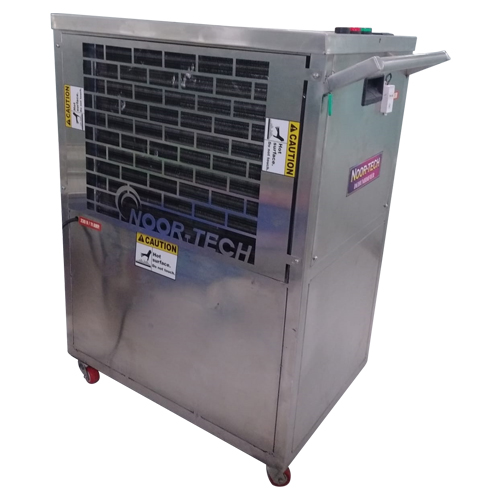Dehumidifier
- Home
- Dehumidifier
- Air cooled devices force moist air over a cold, dehumidifying coil. The moisture condenses out of the air onto the coil and drains from the coil into a container.
- Balanced Refrigerant Circuit w – 4 Row Evaporator Coil using Automatic Expansion Valve with matched Refrigerant Nozzle and Distributor • Rifled Copper Tube and Aluminum Fin Evaporator and Condenser (Re-heat) Coils • Oversized Refrigerant System Accumulator • R-22 Refrigerant • 24V Control Board – with interlock for air handler blower • Voltage 115v 60Hz
- Industrial Dehumidifiers are used in different industrial applications that help in corrosion prevention, Condensation protection, Moisture regain Prevention, Fungus prevention, Product Drying, Low Humidity etc…
- What is humidity?Most of the time we don’t give a moment’s thought to the atmosphere in our homes (or outside); why should we, it’s invisible! If we think about it at all, we tend to think of it as a gas. Look up at the sky and you see a different point of view. Clouds whizzing over your head are a sure sign that the air contains water, either as a vapor (if it’s dry) or liquid (if it’s actually raining). But the same is true inside your home. You might think the air is dry—and if you have central heating, it might even feel that way—but there’s a huge amount of moisture around you too. If you dry laundry inside your home or do a lot of stove-top cooking without proper ventilation, the humidity levels can be surprisingly high. Condensation on the windows (or, even worse, water dripping down the walls—as it sometimes does in my kitchen) is a sure sign of a humidity problem.

What does a dehumidifier do?
A dehumidifier is a bit like a vacuum cleaner: it sucks in air from your room at one end, takes the moisture out of it, and then blows it back out into the room again. The moisture drips through into a collection tank that you have to empty, from time to time. How is the moisture removed? That’s where a dehumidifier is more like an air conditioning unit (sometimes called an air-con or HVAC, which stands for heating ventilating air conditioning unit), which, itself, works a bit like a refrigerator.How does a dehumidifier work?
Dehumidifiers work as refrigeration (cooling air to remove moisture using similar technology to a refrigerator or air conditioner)Refrigeration
- Warm, moist air is sucked in through a grille on one side of the machine.
- An electric fan draws the air inward.
- The warm air passes over freezing cold pipes through which a coolant circulates. (Note: We’ve simplified this part of the machine quite a lot. It’s like a mini air-conditioner or refrigerator endlessly circulating coolant with a pump and compressor.) As the air cools, the moisture it contains turns back into liquid water and drips downward off the pipes.
- Now free of moisture, the air passes over the hot condensor/compressor unit and warms back up to its original temperature.
- Warm, dry air blows back into the room through another grille.
- The moisture that was in the air originally drips down into a collecting tray (or bucket) at the bottom of the machine.
- A plastic float in the machine rises upward as the collecting tray fills up.
- When the tray is full, the float trips an electric switch that turns off the fan and switches on an indicator light telling you the machine needs emptying
Water removed per day
The simplest one is how much water a dehumidifier removes, measured in liters (or pints) collected in 24 hours of continuous operation: bigger machines will obviously draw out more water than smaller ones. If you have a lot of water to shift very quickly, perhaps after a river flood, this will be the best measurement to go by. In an emergency like this, you don’t really care how much electricity you’re using, since (hopefully) it will only be for a fairly short time.Efficiency
If you’re using a dehumidifier for much longer (perhaps on a permanent basis, because you live in a damp basement), you’ll also need to study how much power your machine consumes. The best measurement in this case is the efficiency of the machine (sometimes called its energy factor), which is how much water it removes divided by how much power it uses, measured in liters (or pints) per kilowatt hour (L/kWh).Specifications
Selecting industrial dehumidifiers requires an analysis of product specifications.
Air volume is the amount of air that passes through the dehumidifier. It is measured as a volume per unit time, such as cubic feet per minute (ft3/min).
Moisture removal is the amount of moisture that is removed from air that passes through the dehumidifier. Like air volume, moisture volume is measured as a volume per unit time, but typically in pounds per hour.
Relative humidity is a measure of the amount of water in the air compared with the amount of water that the air can hold at the time of measurement.
Dew point temperature is the temperature at which air cools at constant pressure in order to reach saturation. Typically, dew point is measured in degrees Fahrenheit (F).
